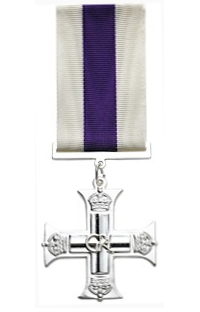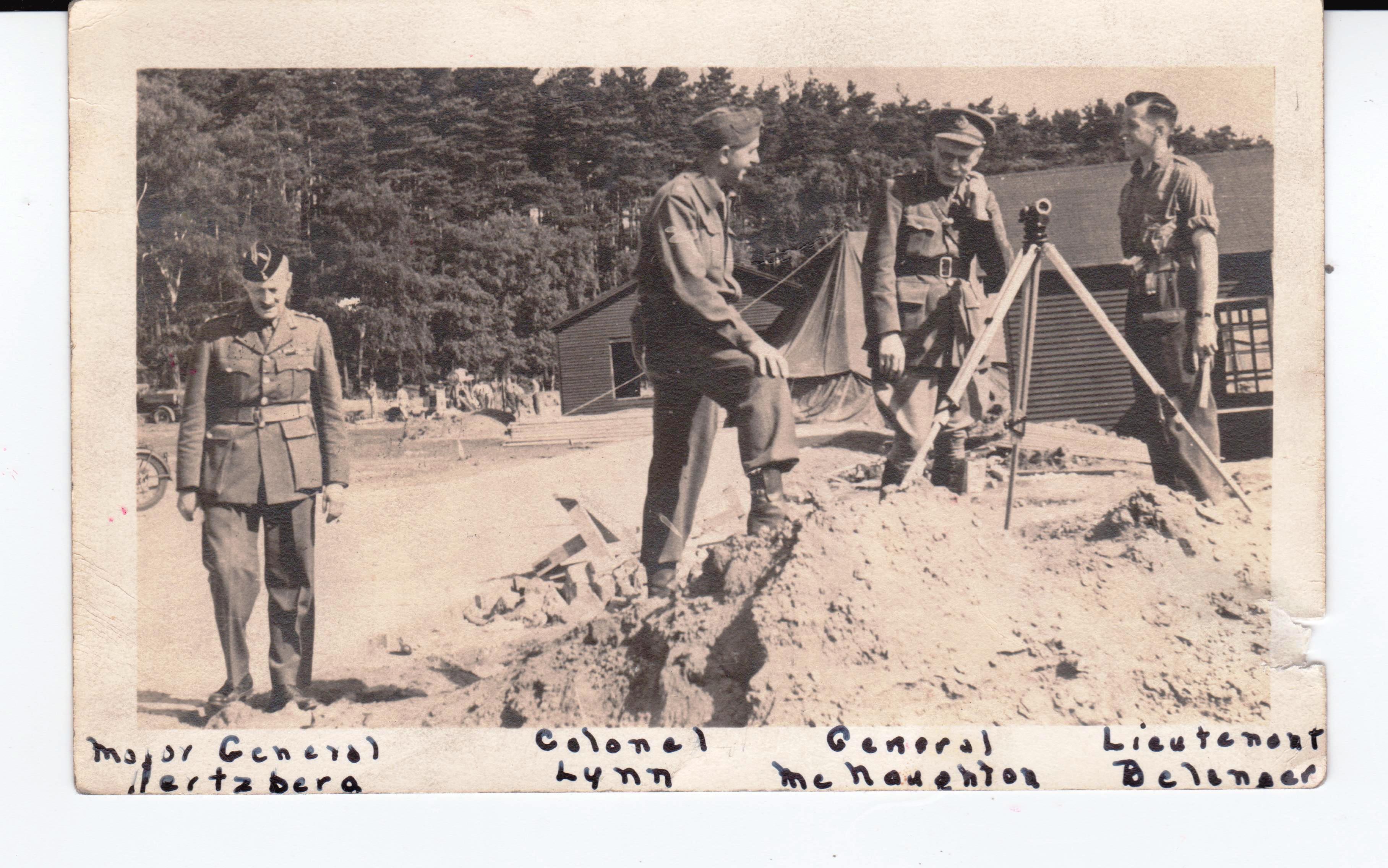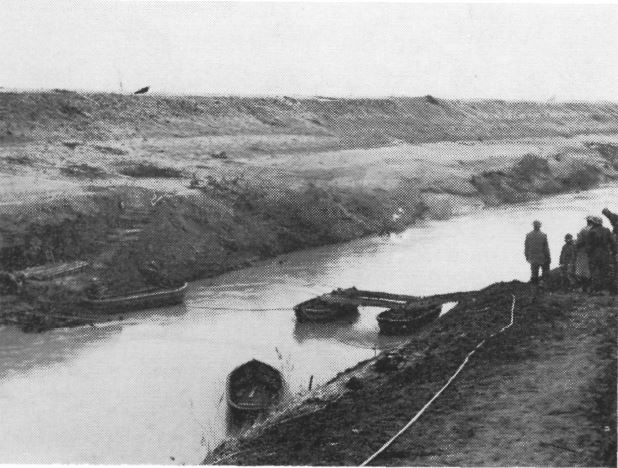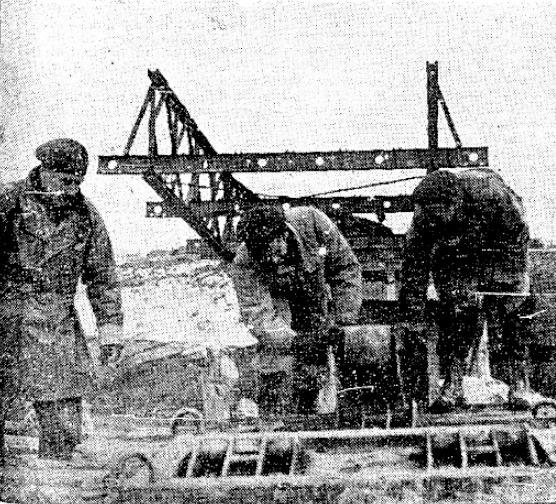Arnold Reginald "Arnie" Belanger was born in Elk Lake, Ontario, the eighth child of J.O. and Rose Ann Dawson Belanger. His father was the Station Agent for the T&NO (Temiskaming & Northern Ontario Railway) at the time.
When the railway offered his father a new position and the family moved to Haileybury, ON, Arnie attended Elk Lake Public School from 1922 until 1928. Arnie completed Grade XIII at Haileybury High School which at that time, ran concurrent courses for the Haileybury Mining School. The Haileybury School of Mining today offers post-secondary courses under the umbrella of the Northern College of Applied Arts and Technology.
On leaving school, Arnie worked first at an Assay Office in Haileybury (Bell Analytical Lab), then moved to Swastika, ON where he was employed as an Assayer at the Golden Gate Mine. His work experience also included surveying and draughting. Arnie enlisted as a Sapper in the 1st Pioneer Battalion on 25 May 1940 in Kirkland Lake, ON. He declared his occupation as being mining engineer assistant.
The battalion was largely being assembled in Toronto and was shipped to England in June. Once there, they build camps, roads, airfields and defence works until the threat of invasion was over. Arnie was appointed Lance-Corporal in June 1942 and later promoted to Sergeant in February 1943. In April 1943, he was selected to attend officer training at the Royal School of Military Engineering in Chatham, Kent. He completed the course on 11 October 1943 and was commissioned as a Lieutenant. (see photo). On being commissioned, he was posted to the 4th Battalion, RCE which had just been broken up into the 29th, 30th, and 31st Field Companies and the 8th Field Park Company.
On 30 May 1944, Arnie was placed on the X-10 reinforcement list and sent to Italy. He was taken on strength of the 1st Field Company on 5 September 1944, a week after the month-long Gothic Line battle had begun, the biggest battle the Canadians faced during the Italian Campaign.
Once the Gothic Line had been breached, hopes for a rapid advance across the Po River Valley were dashed as unseasonal storms and rains washed out bridges and flooded low lying areas. On October 11, the 1st Canadian Infantry Division returned to the line and fought in water-logged terrain against a tenacious enemy. It took until 20 October for I Canadian Corps to capture the city of Cesena. The formidable defences of the Savio River were breached, but the Germans counter-attacked, again and again, to throw the Canadians back. Meanwhile, as the Americans were progressing dangerously toward Bologna. The Germans panicked took two crack divisions from the Adriatic front to halt their advance. This reduced a little pressure on the 8th Army and the Canadian Corps in particular and they were able to move up another ten kilometres to the banks of the Ronco River.
Arnie and his company spend the next month in reserve getting some rest but more importantly training for the next stage of the operation, the attack on Ravenna. Although the city fell on 4 December, heavy fighting raged through the rest of the month with few gains. For the Sappers, the Lamone Crossing operation did not end until 13 December. The river itself was only 5 feet deep but in flood conditions, it ran fast and cold.
On the right flank of the Canadian Corps, the 5th Armoured Division closed to the river and were able to cross and establish a tenuous bridgehead. It was more difficult on the 1st Division's front. Dikes on either side rose 25 feet above the plain and 40 feet above the river. It was determined the Arks (bridge-laying tanks) of the 5th Division's Field Squadrons would not be sufficient and using folding boat equipment would be difficult. Ferries and assault bridges were the only options. In a very confused situation of the night 4/5 December, Arnie's platoon was able to get a Class 2 raft operational for a short time, but no other crossings were made. Some jeeps and anti-tank guns were taken over, but all was lost by noon due to continuing German counterattacks.
By 10 December, the situation was getting desperate. The 5th Division bridgehead was intact, but no advances were made and the breakout was stalled. A concerted effort on the 1st Division front was essential. The engineers had a few Class 2 rafts working by the 11th, and dozers able to start knocking down the banks even though they were under both enemy observation and fire. By 0700 hours the next morning, the 1st Field Company had their crossing in place largely due to the bravery of Number 2 Platoon and their leader, Lt Arnie Belanger. Details of Arnie’s work are in the Citation to the Military Cross he received. Heavier bridges followed over the next few days and by the 13th, crossing over the Lamone were well established. The fighting continued right up the mid-January and after a short stand down, I Canadian Corps started withdrawing from Italy in February 1945 to rejoin the First Canadian Army in northwest Europe.
Arnie had served with distinction throughout the war and especially with the 1st Field Company in Italy and Northwest Europe during the Second World War. Interestingly. he was among the last to face the enemy in Germany when two days after the armistice he was stopped by armed German troops while doing a reconnaissance forward of the cease-fire line.
Upon his return to Canada, he married Jean McQueen of Englehart on 20 September 1945. She had served in the RCAF (Womens' Division). They initially lived in Virginiatown where Arnie worked for the Kerr Addison Mine. In 1952, Arnold began a 32-year distinguished career with Atlas Copco, living in Thunder Bay, Vancouver and Toronto. The couple had three children - Dennis, Janet and Douglas.
Arnie retired as the National Accounts Manager in 1984. He was a member of the Canadian Institute of Mining and Metallurgy, the Prospectors and Developers Association, The United Church, the Lions Club, the Royal Canadian Legion and he assisted with Little League Baseball. He and Jean moved to Sechelt, BC. He died a year later on 1 June 1985. After his death, the Atlas Copco Canada Award, given to a second-year student at the Haileybury School of Mines, was renamed the Atlas Copco – Arnie Belanger Memorial Award. Jean died on 1 December 2005. Their ashes were scattered in the Pacific Ocean off Lighthouse Point on the Sunshine Coast.
(From the files of Diane Belanger Armstrong)
On the night of 11/12 December 1944, 3 Canadian Infantry Brigade was ordered to establish a bridgehead over the Lamone River, in the area Map Reference 4135. The brigade was supported in this operation by 1 Canadian Field Company, Royal Canadian Engineers, who were able to build a bridge at the only suitable site in the area, Map Reference 415352. Lieutenant Arnold Reginald Belanger commanded No.3 Platoon of this company.
The task of the platoon was to establish a Class 2 raft crossing at Map Reference 415352 and subsequently to build a bridge for Class 9 vehicles at the same site. This area, as was subsequently established, was included in the enemy's defensive fire plan, and was the scene of heavy and frequent mortaring and shelling from the start of the operation. Lieutenant Belanger, showing the greatest tenacity and drive, however, so organized and pressed the work that the raft crossing for anti-tank guns and jeeps was completed by 0800 hours on the 12th of December 1944. During daylight, as the operation progressed, shelling of the area increased in intensity. Lieutenant Belanger realized the urgency of the task and by arranging shifts and reliefs to minimize the strain of the constant shellfire, was able to finish most of the approach work for the bridge by darkness. He himself, however, remained in control of the work throughout. During this period, the platoon suffered casualties to personnel, equipment and vehicles from the enemy fire.
Immediately darkness began to fall, vehicles carrying the bridging equipment were able to come up, and Lieutenant Belanger and his men turned to the task of erecting the bridge. All were tired by now and the shelling and mortaring continued unabated. Such was Lieutenant Belanger's drive, energy and example, however, that the work continued unchecked, and a Class 9 crossing over the river obstacle was completed by first light on 13 December.
The courage and example under fire displayed by this officer undoubtedly helped to sustain the morale and working enthusiasm of his men. It was largely as a result of his leadership and bravery that the bridge, which for several hours was the only crossing over the Lamone and was the lifeline of the brigade, was able to be completed as early as it was.



